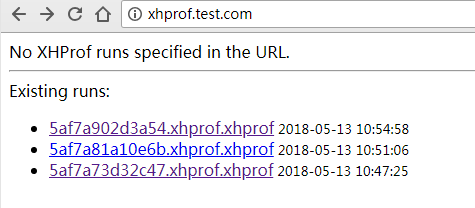wget http://pecl.php.net/get/xhprof-0.9.4.tgztar zxf xhprof-0.9.4.tgzcd xhprof-0.9.4/extension/sudo phpize./configuresudo makesudo make installcd ../
配置php.ini
[xhprof]extension=xhprof.soxhprof.output_dir=/tmp注:xhprof已经很久没有更新过了,截至目前还不支持php7,php7可以使用 https://github.com/phacility/...。配置xhprof环境
需要把xhprof压缩包里的两个目录复制到指定目录(假设定义到 /work/xhprof/):
mkdir /work/xhprof/cp -a xhprof_html/ /work/xhprof/cp -a xhprof_lib/ /work/xhprof/
然后在项目框架的入口文件添加:
xhprof_enable(XHPROF_FLAGS_MEMORY | XHPROF_FLAGS_CPU);register_shutdown_function(function() { $xhprof_data = xhprof_disable(); if (function_exists( fastcgi_finish_request )){ fastcgi_finish_request(); include_once /work/xhprof/xhprof_lib/utils/xhprof_lib.php include_once /work/xhprof/xhprof_lib/utils/xhprof_runs.php $xhprof_runs = new XHProfRuns_Default(); $run_id = $xhprof_runs- save_run($xhprof_data, xhprof });
代码解析:
$xhprof_data中记录了程序运行过程中所有的函数调用时间及CPU内存消耗,具体记录哪些指标可以通过xhprof_enable的参数控制,目前支持的参数有:
HPROF_FLAGS_NO_BUILTINS 跳过所有内置(内部)函数。
XHPROF_FLAGS_CPU 输出的性能数据中添加 CPU 数据。
XHPROF_FLAGS_MEMORY 输出的性能数据中添加内存数据。
之后的处理已经与xhprof扩展无关,大致是编写一个存储类XHProfRuns_Default,将$xhprof_data序列化并保存到某个目录,可以通过XHProfRuns_Default(__DIR__)将结果输出到当前目录,如果不指定则会读取php.ini配置文件中的xhprof.output_dir,仍然没有指定则会输出到/tmp。
xhprof_enable和xhprof_disable是成对出现的,一个是代码运行最前面,一个是最后面。中间是要分析的代码。
经过上面的配置后,我们后续请求项目的接口,xhprof就会分析请求过程中的CPU、内存、耗时等内容。日志保存在xhprof.output_dir目录。
配置web配置好了,怎么查看日志呢?我们可以搭建一个简单的web server:
xhprof.test.com.conf
server { listen 80; server_name xhprof.test.com; root /work/xhprof/xhprof_html; index index.html index.php;
fastcgi_index index.php; fastcgi_param SCRIPT_FILENAME $document_root$fastcgi_script_name; include fastcgi_params;}然后配置虚拟主机xhprof.test.com。重启nginx,打开 xhprof.test.com就可以看到效果了:

默认的UI里列出了:
funciton name : 函数名
calls: 调用次数
Incl. Wall Time (microsec): 函数运行时间(包括子函数)
IWall%:函数运行时间(包括子函数)占比
Excl. Wall Time(microsec):函数运行时间(不包括子函数)
EWall%:函数运行时间(不包括子函数)
在web中还可以看到 [View Full Callgraph] 链接,点击后可以绘制出一张可视化的性能分析图,如果点击后报错的话,可能是缺少依赖graphviz。graphviz是一个绘制图形的工具,可以更为直观的让你查看性能的瓶颈。如果需要可以安装:
yum install -y libpngyum install -y graphviz
效果:![1530948741239972.png 2522854532-5b27c405e2d35_articlex[1].png](http://img.VeVb.com//upload/image/237/513/460/1530948741239972.png)
前面我们是通过在项目入口文件添加代码实现了分析的功能。更优雅的方式是新建一个额外的文件 xhprof.inc.php,保存在/work/xhprof/目录下:
xhprof_enable(XHPROF_FLAGS_MEMORY | XHPROF_FLAGS_CPU);register_shutdown_function(function() { $xhprof_data = xhprof_disable(); if (function_exists( fastcgi_finish_request )){ fastcgi_finish_request(); include_once /work/xhprof/xhprof_lib/utils/xhprof_lib.php include_once /work/xhprof/xhprof_lib/utils/xhprof_runs.php $xhprof_runs = new XHProfRuns_Default(); $run_id = $xhprof_runs- save_run($xhprof_data, xhprof });利用PHP的自动加载功能,在执行代码前注入此文件,编辑php.ini:
auto_prepend_file = /work/xhprof/xhprof.inc.php
然后重启PHP服务。这样所有使用该php环境的都会生效。
或者写到指定项目的nginx配置里也行:
jifen.cc.conf
location ~ /.php$ { fastcgi_pass 127.0.0.1:9000; fastcgi_index index.php; fastcgi_param SCRIPT_FILENAME $document_root$fastcgi_script_name; fastcgi_param PHP_VALUE auto_prepend_file=/work/xhprof/xhprof.inc.php include fastcgi_params; }然后重启nginx服务。这样仅该项目生效。
郑重声明:本文版权归原作者所有,转载文章仅为传播更多信息之目的,如作者信息标记有误,请第一时间联系我们修改或删除,多谢。
新闻热点
疑难解答